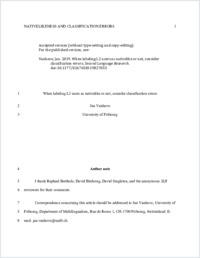When labeling L2 users as nativelike or not, consider classification errors
BLE-BLL
- Vanhove, Jan University of Fribourg
-
18.02.2019
29
English
Researchers commonly estimate the prevalence of nativelikeness among second-language learners by assessing how many of them perform similarly to a sample of native speakers on one or several linguistic tasks. Even when the native (L1) samples and second-language (L2) samples are comparable in terms of age, socio-economic status, educational background and the like, these nativelikeness estimates are difficult to interpret theoretically. This is so because it is not known how often other native speakers would be labeled as non-nativelike if judged by the same standards: if some other native speakers were to be labeled as non-nativelike, then it is possible that some second-language learners that were categorized as non-nativelike are actually nativelike. Two methods for estimating the classification error rate in nativelikeness categorizations – one conceptually straightforward but practically arduous, and one involving the re-analysis of the original studies’ data – are proposed. These approaches underscore that, even if one conceives of nativelikeness as a binary category (nativelike vs. non-nativelike), the data collected in any given study may not allow for such neat categorizations.
- Faculty
- Faculté des lettres et des sciences humaines
- Department
- Département de plurilinguisme et didactique des langues étrangères
- Language
-
- English
- Classification
- Language, linguistics
- License
-
License undefined
- Identifiers
-
- RERO DOC 324140
- DOI 10.1177/0267658319827055
- Persistent URL
- https://folia.unifr.ch/unifr/documents/307631
Statistics
Document views: 175
File downloads:
- Texte intégral: 258
